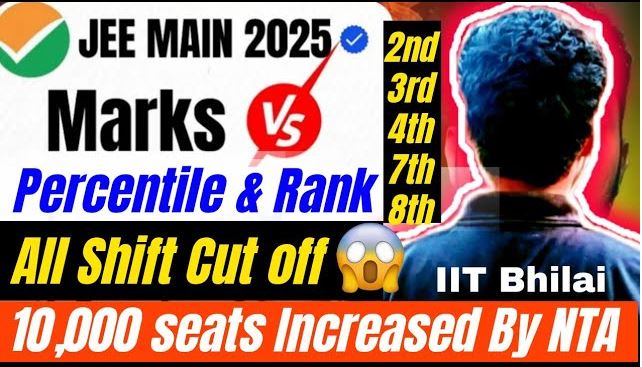JEE Main 2025 Paper Analysis LIVE Updates: April 8 shift one exam begins, how was yesterday’s BE, BTech paper?
JEE Main 2025 April 08 Shift 1 Question Paper Answer Key LIVE Updates: JEE Main 2025 April 8 Shift 1 Exam Analysis: The NTA continues the Session 2 exam with Paper 1 for BTech/BE candidates, assessing difficulty, topics, and performance for JEE Advanced eligibility.
JEE Main 2025 April 8 Shift 1 Paper Exam Analysis LIVE Updates:
The National Testing Agency (NTA), which began conducting the JEE Main 2025 Session 2 exams on April 2 for BTech and BE courses, has concluded the fourth day of the examination on April 7. Paper 1 of JEE Main 2025 is scheduled on April 2, 3, 4, 7, and 8, while Paper 2 is set to take place on April 9, 2025.

On April 8, the exam is being conducted in two shifts: the first shift runs from 9 am to 12 noon, and the second shift will be held from 3 pm to 6 pm.
Both shifts are being administered as computer-based tests across designated exam centers for registered candidates. After a shift concludes, candidates can check the JEE Main 2025 question papers and get updates on the JEE Main analysis after the end of the shifts.
JEE Main Rank Predictor
Candidates who rank within the top 2.5 lakh performers in JEE Main 2025 will be eligible to appear for the JEE Advanced 2025 exam, which is a centralized gateway to admission in the Indian Institutes of Technology (IITs).
JEE Main 2025 April 8 Paper Analysis LIVE: Conceptual clarity vital for scoring in Physics and Maths
Success in yesterday’s paper depended heavily on conceptual understanding in Physics and Mathematics. While Physics rewarded accuracy, Mathematics required speed and precision due to its time-consuming nature
JEE Main 2025 Paper Analysis LIVE: April 8 exam starts
The NTA has started the April 8 exam today at 9 am

JEE Main 2025 April 7 Paper Analysis LIVE: April 7 paper followed balanced chapter-wise distribution
Despite subject-wise differences in difficulty, the overall chapter distribution was relatively balanced in all three sections. No subject was dominated by any single chapter, making the paper fair for all aspirants.
JEE Main 2025 April 7 Paper Analysis LIVE: Chemistry remains the most scoring subject
In JEE Main 2025 April session so far, chemistry has been consistently one of the most scoring subjects due to its reliance on NCERT and direct theoretical questions. Even difficult papers had manageable chemistry sections compared to math.
JEE Main 2025 April 7 Paper Analysis LIVE: Lengthy questions challenge even top-performing students
Some of the questions in Mathematics were so lengthy and multi-layered that even well-prepared candidates found it hard to maintain speed. This made accuracy under pressure a deciding factor in performance.
IIT JEE Advanced 2025 Registration: IIT Kanpur has started the application process for
the JEE Advanced 2024 for foreign national candidates including OCI and PIO candidates at the official website — jeeadv.ac.in. The registration link will remain open till May 2 for all candidates.
Shift 1 of the JEE Main 2025 April 7 exam concluded without any major technical issues. Candidates exited test centres stating that the paper was in line with expected pattern, albeit with a tough Maths section.
JEE Main 2025 April 7 Paper Analysis LIVE: Physics section was easy to moderate in difficulty
The Physics section included mostly formula-based and numerical questions. Experts say the difficulty level was easy to moderate, offering scoring potential to students with a strong conceptual foundation.
Topics like Mechanics, Modern Physics, Electrostatics, Ray Optics, and Units & Measurements formed the backbone of the Physics paper. Their high weightage offered solid scoring ground for well-prepared students.
Surprisingly, today’s Maths section had limited coverage from Calculus and Matrices. Instead, more questions were asked from Conic Sections and 3D Geometry, reflecting a change in trend from earlier sessions
The Chemistry section provided a major scoring opportunity, as it was filled with straightforward questions, mostly theory-based and directly from the NCERT syllabus. Statement-based questions were predominant.
Lengthy calculations and complex multi-step problems in the Mathematics section consumed significant time, making it difficult for students to complete the paper comfortably. Time management proved to be a major hurdle
The Mathematics section saw a strong presence of 3D Geometry, Vectors, and Conic Sections. In contrast, topics like Calculus and Matrices appeared less frequently, shifting the focus away from traditionally dominant areas.
Experts have ranked the overall difficulty of the April 7 Shift 1 paper as Mathematics being the toughest, followed by moderately difficult Physics, and Chemistry as the easiest and most scoring.
According to experts, Mathematics was the most challenging section in today’s paper. The problems were lengthy, requiring multiple steps and deep conceptual clarity. Topics like 3D Geometry, Vectors, and Conic Sections dominated the section.
Students who appeared in the April 3 afternoon shift reported a relatively easier Physics section. Maths was moderately difficult, and Chemistry featured tricky statement-based questions, increasing overall difficulty slightly.
Across April 2 to 4, EMI, Rotation, and AC were largely absent in the Physics section. The focus stayed on Optics, Electrostatics, Modern Physics, and Units & Measurements, according to expert breakdowns of each shift.
The April 3 second shift had a Math section filled with complex problems from matrices, 3D, and vectors. Though formula-based, these questions took time, making it challenging to attempt the full section within the allotted time.
From April 2 to April 4, Chemistry questions were heavily borrowed from NCERT textbooks, especially in the theoretical part. Inorganic chemistry had maximum weightage, while organic saw minimal representation, especially in the April 3 morning paper.
April 4’s evening session was deemed moderate by experts. Chemistry was once again dominated by inorganic topics, while Physics stayed largely numerical. Maths, though, challenged students with lengthy and calculation-heavy problems